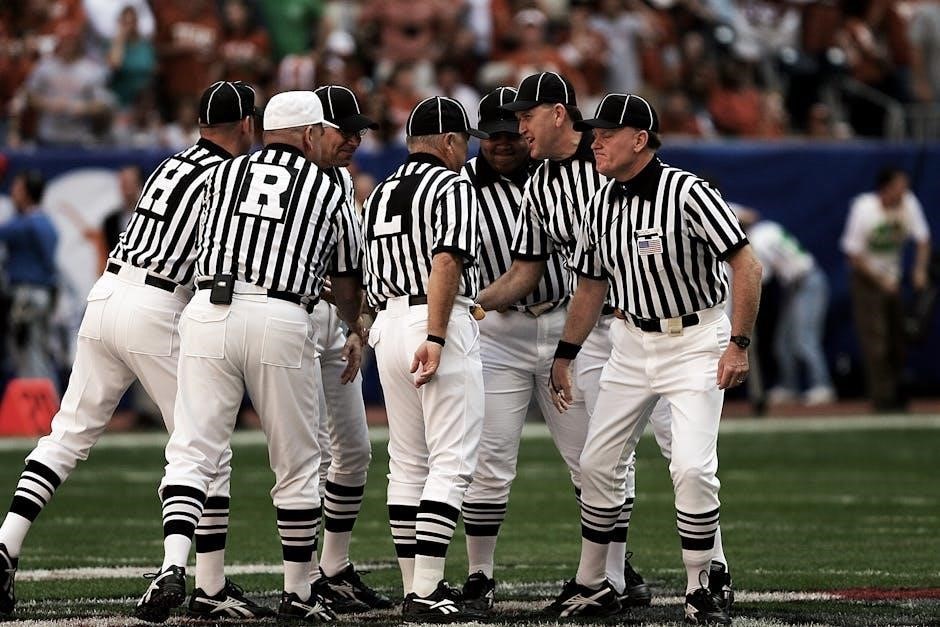Discover the essentials of craps with a Craps Rules PDF, a comprehensive guide covering game rules, payout odds, and strategies. Perfect for beginners and experienced players alike, it simplifies the game’s complexity, ensuring a smooth learning curve and enjoyable gameplay.
What is Craps?
Craps is an exciting dice game where players take turns rolling two dice, betting on various outcomes. It combines strategy and luck, offering multiple betting options. The game starts with a “come-out” roll, determining the initial direction of the game. Players can wager on the shooter’s success or failure, with options like the Pass Line, Don’t Pass, and Odds bets. Craps is known for its fast-paced action and social interaction, making it a popular choice in casinos worldwide. Understanding the rules and payout odds is essential to mastering the game, as outlined in the Craps Rules PDF, which provides a detailed guide for both beginners and experienced players.
Basic Rules of Craps
The core of craps revolves around the shooter’s dice roll, with the game divided into rounds. A round begins with the “come-out” roll, where the shooter aims to establish a “point” by rolling a 4, 5, 6, 8, 9, or 10. If a 2, 3, or 12 is rolled, the round ends immediately. Players bet on outcomes such as the shooter’s success or failure, with the Pass Line and Don’t Pass bets being the most common. Odds bets can be placed to increase potential winnings. The game continues until the point is rolled again or a 7 is rolled, ending the round. Understanding these rules, as detailed in the Craps Rules PDF, is crucial for mastering the game.
Why Craps is Popular
Craps is one of the most popular casino games due to its fast-paced action, social atmosphere, and variety of betting options. Players gather around the table, creating a lively and engaging environment. The game’s simplicity, combined with its depth of strategy, appeals to both newcomers and experienced gamblers. The Craps Rules PDF highlights how the game’s payout odds and low house edge make it attractive, offering some of the best bets in the casino. Additionally, the thrill of rooting for the shooter and the potential for high payouts contribute to its widespread appeal. The guide ensures players understand the rules and strategies, making it accessible to everyone.

Equipment and Setup
A standard craps table features a layout with numbered and lettered sections for bets. The game requires two six-sided dice and a shooter to roll them. Players gather around the table, placing bets according to the rules outlined in the Craps Rules PDF.
Casino Craps Table Layout

The casino craps table is a large, rectangular surface covered in felt, featuring various numbered and lettered sections for placing bets. The layout includes the Pass Line, Don’t Pass, Come, and Odds sections, which are essential for the game’s core bets. The table also has areas for Proposition Bets, such as Any Seven, Hard Ways, and Hop Bets, offering additional wagering options. Players place their chips on the felt, and the table’s rail provides a convenient space for holding chips and beverages. The layout is designed to accommodate multiple players, with clear markings to guide bet placement. Understanding the table’s structure is crucial for navigating the game effectively, as outlined in the Craps Rules PDF.
Dice and Their Importance
In Craps, dice are the central component, determining game outcomes. Players take turns rolling two standard six-sided dice, each bearing numbers from 1 to 6. The dice are typically made of plastic or bone and feature precisely arranged dots to ensure fairness. The shooter’s roll determines the game’s progression, with outcomes ranging from establishing the Point to settling bets. The combination of dice rolls creates 36 possible outcomes, influencing probabilities and payouts. Proper handling of the dice is essential to maintain game integrity. The Craps Rules PDF outlines the significance of dice in gameplay, ensuring players understand their role in shaping the game’s dynamics and strategies. The dice are not just tools but the heart of the game, driving excitement and decision-making.
Role of the Shooter

The Shooter is the player who rolls the dice in a game of Craps, playing a pivotal role in determining the game’s flow. The Shooter begins with the come-out roll, aiming to establish a Point or achieve an immediate win with a 7 or 11. If a Point is set, the Shooter continues rolling until they either hit the Point again or roll a 7, which ends their turn. The Shooter’s performance directly impacts the outcome of bets placed by all players at the table. The Craps Rules PDF details the Shooter’s responsibilities, including proper dice handling and adherence to betting rules. The Shooter’s role is central to the game’s dynamics, making their participation crucial for progression and excitement. Their turn ends if they lose, passing the dice to the next player.

Basic Rules of Craps
Craps is a dice game where players bet on roll outcomes. The game has a come-out roll and a point phase. The shooter rolls dice, aiming to hit numbers like 7 or 11 for pass line wins or 2, 3, or 12 for losses. Other numbers set a point, and the shooter rolls until repeating it or rolling a 7. Odds bets offer better probabilities after the point. House edge varies; pass line bets are low-risk. Players can also make proposition bets on specific outcomes, though these have higher house edges. Understanding these rules is key to enjoying and excelling at craps.
The Come-Out Roll
The come-out roll is the first roll of the dice in a craps game, marking the start of a new round. It is crucial as it determines the flow of the game. A roll of 7 or 11 results in an immediate win for pass line bettors, while 2, 3, or 12 leads to a loss. If 4, 5, 6, 8, 9, or 10 is rolled, this number becomes the “point,” and the shooter aims to roll it again before rolling a 7. The come-out roll sets the stage for the rest of the game, balancing excitement and strategy. Understanding its outcomes is essential for players to make informed decisions during the game.
Pass Line and Don’t Pass Bets
Pass Line and Don’t Pass bets are fundamental wagers in craps, placed before the come-out roll. The Pass Line bet wins if the shooter rolls a 7 or 11 on the come-out and loses if a 2, 3, or 12 is rolled. If a 4, 5, 6, 8, 9, or 10 is rolled, it establishes a point. The bet then wins if the point is rolled again before a 7. Conversely, the Don’t Pass bet wins if a 2 or 3 is rolled on the come-out and loses on a 7 or 11. If a point is set, Don’t Pass wins if a 7 appears before the point. Both bets offer a low house edge, making them popular among players, especially newcomers to the game.
Establishing the Point
Establishing the point is a critical phase in craps, occurring when the shooter rolls a 4, 5, 6, 8, 9, or 10 during the come-out roll. This number becomes the “point” and is marked on the table. The shooter’s objective is to roll this number again before rolling a 7. If the point is rolled first, Pass Line bets win, while Don’t Pass bets lose. Conversely, if a 7 is rolled before the point, Pass Line bets lose, and Don’t Pass bets win. Once the point is set, the game enters a new stage, focusing on whether the shooter can repeat the point or if a 7 will appear first. This concept is central to craps strategy and betting decisions.

Types of Bets in Craps
Craps offers various betting options, each with unique strategies and risks. Line Bets, Proposition Bets, and Odds Bets are the primary types of bets in craps, each catering to different strategies and player preferences.
Line Bets: Pass and Don’t Pass
Line bets are the most common wagers in craps and include the Pass Line and Don’t Pass bets. The Pass Line bet wins if the shooter rolls a 7 or 11 on the come-out roll and loses if they roll a 2, 3, or 12. If a 4, 5, 6, 8, 9, or 10 is rolled, it establishes a “point,” and the bet remains in place until the shooter either rolls the point again (win) or rolls a 7 (lose). Conversely, the Don’t Pass bet is the opposite, winning on a 2 or 3 and losing on a 7 or 11; If a point is set, the Don’t Pass bet wins if a 7 is rolled before the point. These bets are popular due to their simplicity and relatively low house edge, making them ideal for beginners learning craps.
Proposition Bets
Proposition bets in craps are wagers placed on specific outcomes of a single roll of the dice. These bets are typically high-risk, high-reward and are independent of the shooter’s point or the main game flow. Common examples include betting on the roll of a 7, 11, or 12 (known as “Yo” or “Any Craps”), or betting on whether the next roll will be even or odd. Proposition bets often have higher payouts due to their lower probability of winning. For instance, a bet on “Any Craps” (rolling a 2, 3, or 12) pays 7:1, while a bet on “Yo” (rolling an 11) pays 15:1. These bets are popular among players seeking quick action and excitement, though they carry a higher house edge compared to line bets.
Odds Bets
Odds bets in craps are additional wagers placed after a point has been established. These bets are directly tied to the pass line or don’t pass bets and offer some of the best odds in the game. When a point is set, players can bet on whether the shooter will roll the point again before rolling a 7. Odds bets are paid at true odds, meaning there is no built-in house edge, making them highly favorable for strategic players. For example, a pass line odds bet is paid at 2:1 if the point is 4 or 10, 3:2 for 5 or 9, and 6:5 for 6 or 8. This bet is a key component of advanced strategies and is often recommended for minimizing the house edge.

Advanced Strategies
Advanced strategies in craps involve hedging bets to minimize losses and maximizing wins. Understanding odds bets deeply and managing bankroll effectively are key to long-term success.
Understanding Odds Bets
Odds bets are among the most advantageous in craps, offering no house edge when placed correctly. They can only be made after a point is established on the come-out roll. Odds bets are placed in support of your original pass or don’t pass bet, and their payout is based on the likelihood of the point number being rolled before a 7. The maximum odds bet varies by casino but is typically several times the original bet. Understanding odds bets is crucial for reducing the house edge and maximizing potential winnings. They are a key component of advanced craps strategies and should be used wisely to enhance your gameplay and overall success at the table.
Hedge Betting in Craps
Hedge betting in craps involves placing multiple bets to reduce potential losses by balancing risk and reward. This strategy allows players to offset unfavorable outcomes with favorable ones, minimizing volatility. For example, a player might place both a pass line and a don’t pass bet to hedge against the shooter’s performance. While this approach can reduce risk, it also lowers the overall expected value, as you’re essentially betting against yourself. Hedge betting is often used by experienced players to manage their bankroll more effectively. However, it can complicate the game and is not suitable for everyone. Understanding when and how to hedge requires a solid grasp of craps rules and odds.
Common Mistakes to Avoid
One of the most common mistakes in craps is not understanding the basic rules before placing bets, leading to poor decisions. Many players overlook the importance of managing their bankroll, resulting in overspending. Others fall into the trap of chasing losses, increasing bets recklessly. Ignoring the table minimum and maximum limits is another error, as it can lead to unnecessary financial strain. Additionally, players often misunderstand the odds and house edge, leading to unfavorable wagers. Finally, failing to pay attention to the shooter’s turn or the current state of the game can result in missed opportunities or incorrect bets. Avoiding these mistakes requires patience, knowledge, and disciplined play.

Craps Payout Odds
Craps payout odds vary based on bets, with Pass Line offering 1:1, while Proposition Bets like Any 7 provide 4:1. Odds bets have no house edge.
Understanding Payout Structures
Craps payout structures are designed based on the probability of specific outcomes. The game offers a wide range of payouts, from 1:1 for even-money bets like Pass Line to higher payouts for less likely events. For example, Proposition Bets such as “Any 7” typically pay 4:1, while harder-to-hit combinations like “Hard 8” may offer 7:1 or higher. Odds Bets, which are based on the Point, have no house edge and pay according to the true probability of the dice roll. Understanding these payout structures is crucial for managing your bankroll and making informed betting decisions. Always refer to the Craps Rules PDF for a detailed payout chart to maximize your strategy.
House Edge in Craps Bets
The house edge in craps varies significantly depending on the type of bet placed. For example, the Pass Line and Don’t Pass bets have a low house edge of approximately 1.4%, making them attractive for beginners. However, other bets like Proposition Bets can have a much higher house edge, sometimes exceeding 16%. Understanding the house edge is crucial for minimizing losses and maximizing winning potential. Bets with lower house edges, such as placing the 6 or 8, offer better odds for players. By focusing on these bets, players can improve their chances of success. Always consult the Craps Rules PDF for detailed house edge information to make informed decisions at the table.
Best Bets for Beginners
For newcomers to craps, it’s essential to start with simple and low-risk bets to ease into the game. The Pass Line bet is an excellent starting point, offering a low house edge and straightforward rules. You wager that the shooter will roll a 7 or 11 on the come-out roll, making it easy to follow and enjoy. Similarly, the Don’t Pass bet is its opposite, betting on a 2 or 3 on the come-out roll or a 7 before the point, also with a low house edge, providing a balanced option for those who prefer to bet against the shooter.
The Odds bet is another great option, available after the point is set, with no house edge, making it a fair and advantageous choice. Placing the 6 or 8 is also beginner-friendly, with moderate house edges and clear outcomes. While the Field bet offers a higher chance of winning on each roll, it’s wise to avoid complex Proposition bets initially, as they carry higher risks and complexities. Starting with these foundational bets allows beginners to gain confidence and familiarity before exploring more advanced strategies.

Craps Rules PDF Guide
A comprehensive guide offering detailed rules, strategies, and betting tips for craps. Perfect for beginners and experienced players, it provides clear explanations and practical examples to enhance gameplay. Covering key concepts and terminology, this PDF is a valuable resource for mastering craps effectively.
Downloading the Craps Rules PDF
Downloading a craps rules PDF is a straightforward process that provides easy access to comprehensive guides. Many online casinos and gaming websites offer free PDF downloads, making it simple to learn and reference the rules anytime. To download, visit a reputable gaming site, locate the craps section, and click on the provided link. Ensure the PDF is from a trusted source to avoid outdated or incorrect information. Once downloaded, you can save it to your device for offline access or print it for convenience. This resource is ideal for beginners and experienced players alike, offering a detailed yet concise guide to mastering craps.
Key Sections in the Craps PDF
A comprehensive craps rules PDF typically includes several essential sections designed to help players understand and master the game. The guide usually starts with an overview of the game, followed by detailed explanations of basic rules, betting strategies, and payout structures. Additional sections often cover advanced techniques, such as hedge betting and odds bets, to cater to experienced players. Many PDF guides also include visual aids like diagrams of the craps table and step-by-step instructions for placing bets. Some versions may even provide troubleshooting tips for common mistakes and a glossary of craps terminology. These sections ensure that both newcomers and seasoned players can enhance their knowledge and improve their gameplay.
How to Use the Guide Effectively

To maximize the benefits of a craps rules PDF, start by reviewing the guide thoroughly before playing. Begin with the basic rules and betting options to build a strong foundation. Practice the strategies outlined in the guide by applying them in a casino or online setting. Use the visual aids, such as table layouts and betting charts, to better understand the game mechanics. Regularly reference the guide to refresh your knowledge and avoid common mistakes. Focus on the sections that align with your skill level, whether you’re a beginner or an advanced player. By combining theoretical knowledge with practical application, you’ll improve your gameplay and increase your chances of success at the craps table.